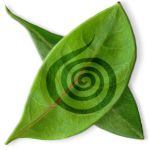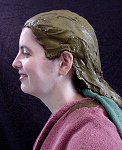| Jump
to: |
The Encyclopedia of Henna Samples Indigo Science History Health Gray Suppliers Beauticians Links Warnings Allergies PPD Dyes Forum Find It! |
 |
| Jump
to: |
The Encyclopedia of Henna Samples Indigo Science History Health Gray Suppliers Beauticians Links Warnings Allergies PPD Dyes Forum Find It! |
 |

Techniques
So, how do you henna your
hair?

|
Henna Pack Implements and
Supplies: Procedure: 1. Prepare Patron. See that patron's clothing is completely covered with dye cape. 2. Mix and
heat henna
in top of double boiler. 3. Shampoo
hair 4. Towel dry hair. Leave hair a little moist, for henna will cling to a damp surface and action will be faster. 5. Protect hands with rubber gloves. 6. Comb
and part hair
in four sections. 7. Apply
henna paste. 8. Adjust wax cap. Cap is used to avoid drippage and to assist in retaining heat. 9. Test
for desired
shade. 10. Rinse out henna with strong spray. 11. Shampoo hair thoroughly. Use as many applications of shampoo as you find necessary to remove all henna and stain from scalp. 12. Give a cream rinse and set hair in desired style. 13. Clean shampoo bowl and utensils; sterilize tools. 14. Make out complete record. Review Questions and Answers: 1. Why is
it not necessary
to give a predisposition test for henna? 2. Name
three precautions
to be observed in using henna. 3. What
effect has
henna on the hair? 4. How
should the
clothing of an operator be protected? 5. How
are henna stains
removed from the skin? 6. Why is
the use
of enamelware and wooden spoons recommended? 7. When
are cloves
added to henna? What is a
compound henna
pack, and when it is it used? On what types
of hair
should Egyptian henna never be used? Editor's note:
the text seems
to discourage henna, and promote the "more natural looking"
paraphenylendiamine
dyes, "with para-phenylendiamine, it is possible to duplicate the most
unusual shade of human hair without impairing its lustre or texture.
...
A small percentage of patrons are sensitive to aniline derivative dyes
(PPD). To identify such individuals is required for all patrons
prior
to applying the dye. This is required by law." ( The
tests
require that a the PPD hair dye be applied behind the ear, and the
patron
return 24 hours later, to be examined for inflammation, redness,
itching, sensitivity.) Note: PPD dyes cause
delayed
hypersensitivity reactions which may not begin for 3 -10 days!
To its credit,
this book
describes several contagious diseases and describes how to avoid
spreading
them from patron to patron: Diphtheria, Gonorrhea, Tuberculosis,
Typhoid
Fever, Influenza, and Syphilis. It mentions that pathogenic bacteria
cannot
be seen with the naked eye. It warns against uncovered coughing,
sneezing, and spitting in public. It warns against unclean hands,
unclean instruments, open sores and pus, mouth and nose discharges, and
common use of drinking cups and towels. It warns that pus is a sure
sign
of the presence of an infectious disease. It states that implements can
be sterilized with warm soapy water and alcohol (though electric
clippers
should be disconnected before putting into water).. Various and Sundry quotes from this amazing book: Hair tinting and Bleaching ... (referring to aniline, coal tar ... paraphyenylenediamine hair dyes) ... is sure repeat business. The patron who once starts to have her hair tinted must keep right on coming to your shop at regular intervals. ...it will become one of your most profitable fields of income. Tinted or Bleached Hair has Advantages to Certain Women: 1. The business woman who perhaps feels that the shade of her hair is a handicap to her business. 2. The woman who is married to a man of much younger appearance. 3. The young unmarried woman, whose hair has turned prematurely gray. 4. Gray haired
women who
wish to appear younger. And, never
forget: Straight hem, no
drooping
slip! Reference: |
 Henna For Hair is devoted to the art and science of dying hair with natural dyes. Natural hair dyes are good for your health, and good for your planet! Can't find what you're looking for here? Try the Henna For Hair Main Index |
Logo
by Alex
Morgan:
Spellstone © 2005
All material unless otherwise noted by Catherine Cartwright-Jones © 2003, 2004, 2005 info@mehandi.com Title
Graphics by Gwyneddh
Jones © 2003
thou
shalt not steal. |